Comprehensive Report: Money and Banking Analysis in Singapore
VerifiedAdded on 2020/10/05
|13
|1772
|68
Report
AI Summary
This report provides a comprehensive analysis of the money and banking system in Singapore, examining key economic indicators and financial policies from 1999 to 2018. It delves into the concepts of narrow and broad money, analyzing their fluctuations and impact on the economy. The report a...

Money and banking
Paraphrase This Document
Need a fresh take? Get an instant paraphrase of this document with our AI Paraphraser
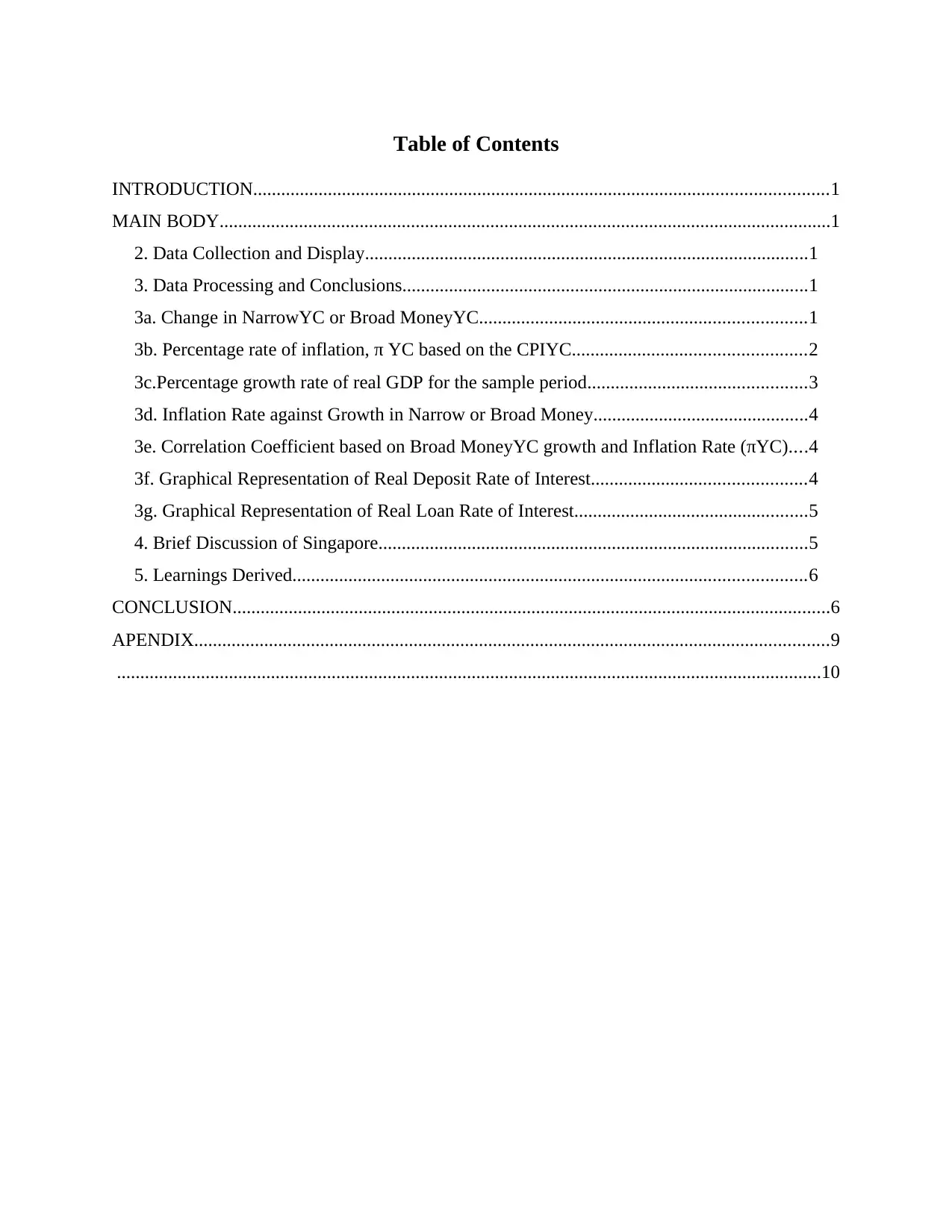
Table of Contents
INTRODUCTION...........................................................................................................................1
MAIN BODY...................................................................................................................................1
2. Data Collection and Display...............................................................................................1
3. Data Processing and Conclusions.......................................................................................1
3a. Change in NarrowYC or Broad MoneyYC......................................................................1
3b. Percentage rate of inflation, π YC based on the CPIYC..................................................2
3c.Percentage growth rate of real GDP for the sample period...............................................3
3d. Inflation Rate against Growth in Narrow or Broad Money..............................................4
3e. Correlation Coefficient based on Broad MoneyYC growth and Inflation Rate (πYC)....4
3f. Graphical Representation of Real Deposit Rate of Interest..............................................4
3g. Graphical Representation of Real Loan Rate of Interest..................................................5
4. Brief Discussion of Singapore............................................................................................5
5. Learnings Derived..............................................................................................................6
CONCLUSION................................................................................................................................6
APENDIX........................................................................................................................................9
.......................................................................................................................................................10
INTRODUCTION...........................................................................................................................1
MAIN BODY...................................................................................................................................1
2. Data Collection and Display...............................................................................................1
3. Data Processing and Conclusions.......................................................................................1
3a. Change in NarrowYC or Broad MoneyYC......................................................................1
3b. Percentage rate of inflation, π YC based on the CPIYC..................................................2
3c.Percentage growth rate of real GDP for the sample period...............................................3
3d. Inflation Rate against Growth in Narrow or Broad Money..............................................4
3e. Correlation Coefficient based on Broad MoneyYC growth and Inflation Rate (πYC)....4
3f. Graphical Representation of Real Deposit Rate of Interest..............................................4
3g. Graphical Representation of Real Loan Rate of Interest..................................................5
4. Brief Discussion of Singapore............................................................................................5
5. Learnings Derived..............................................................................................................6
CONCLUSION................................................................................................................................6
APENDIX........................................................................................................................................9
.......................................................................................................................................................10

⊘ This is a preview!⊘
Do you want full access?
Subscribe today to unlock all pages.

Trusted by 1+ million students worldwide
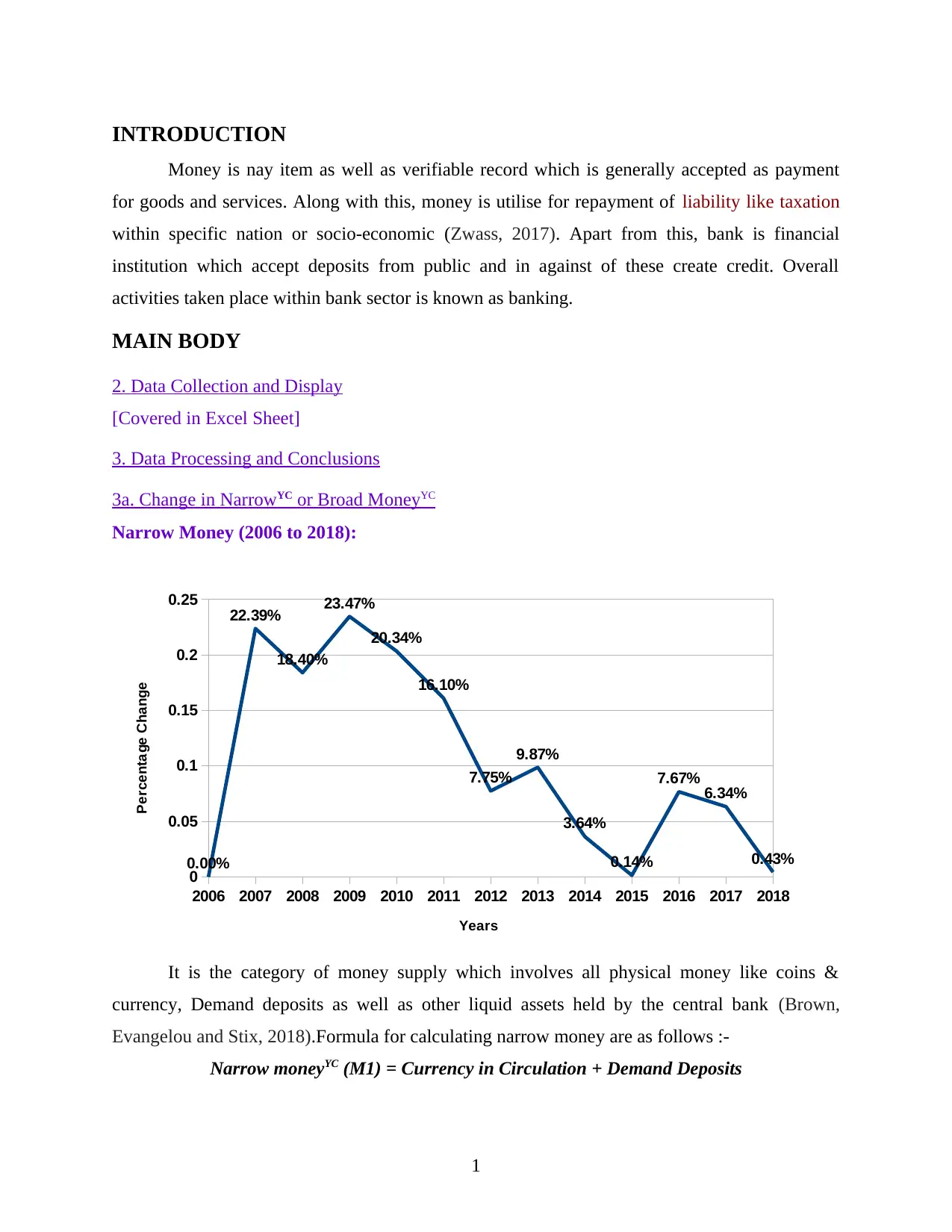
INTRODUCTION
Money is nay item as well as verifiable record which is generally accepted as payment
for goods and services. Along with this, money is utilise for repayment of liability like taxation
within specific nation or socio-economic (Zwass, 2017). Apart from this, bank is financial
institution which accept deposits from public and in against of these create credit. Overall
activities taken place within bank sector is known as banking.
MAIN BODY
2. Data Collection and Display
[Covered in Excel Sheet]
3. Data Processing and Conclusions
3a. Change in NarrowYC or Broad MoneyYC
Narrow Money (2006 to 2018):
2006 2007 2008 2009 2010 2011 2012 2013 2014 2015 2016 2017 2018
0
0.05
0.1
0.15
0.2
0.25
0.00%
22.39%
18.40%
23.47%
20.34%
16.10%
7.75%
9.87%
3.64%
0.14%
7.67% 6.34%
0.43%
Years
Percentage Change
It is the category of money supply which involves all physical money like coins &
currency, Demand deposits as well as other liquid assets held by the central bank (Brown,
Evangelou and Stix, 2018).Formula for calculating narrow money are as follows :-
Narrow moneyYC (M1) = Currency in Circulation + Demand Deposits
1
Money is nay item as well as verifiable record which is generally accepted as payment
for goods and services. Along with this, money is utilise for repayment of liability like taxation
within specific nation or socio-economic (Zwass, 2017). Apart from this, bank is financial
institution which accept deposits from public and in against of these create credit. Overall
activities taken place within bank sector is known as banking.
MAIN BODY
2. Data Collection and Display
[Covered in Excel Sheet]
3. Data Processing and Conclusions
3a. Change in NarrowYC or Broad MoneyYC
Narrow Money (2006 to 2018):
2006 2007 2008 2009 2010 2011 2012 2013 2014 2015 2016 2017 2018
0
0.05
0.1
0.15
0.2
0.25
0.00%
22.39%
18.40%
23.47%
20.34%
16.10%
7.75%
9.87%
3.64%
0.14%
7.67% 6.34%
0.43%
Years
Percentage Change
It is the category of money supply which involves all physical money like coins &
currency, Demand deposits as well as other liquid assets held by the central bank (Brown,
Evangelou and Stix, 2018).Formula for calculating narrow money are as follows :-
Narrow moneyYC (M1) = Currency in Circulation + Demand Deposits
1
Paraphrase This Document
Need a fresh take? Get an instant paraphrase of this document with our AI Paraphraser
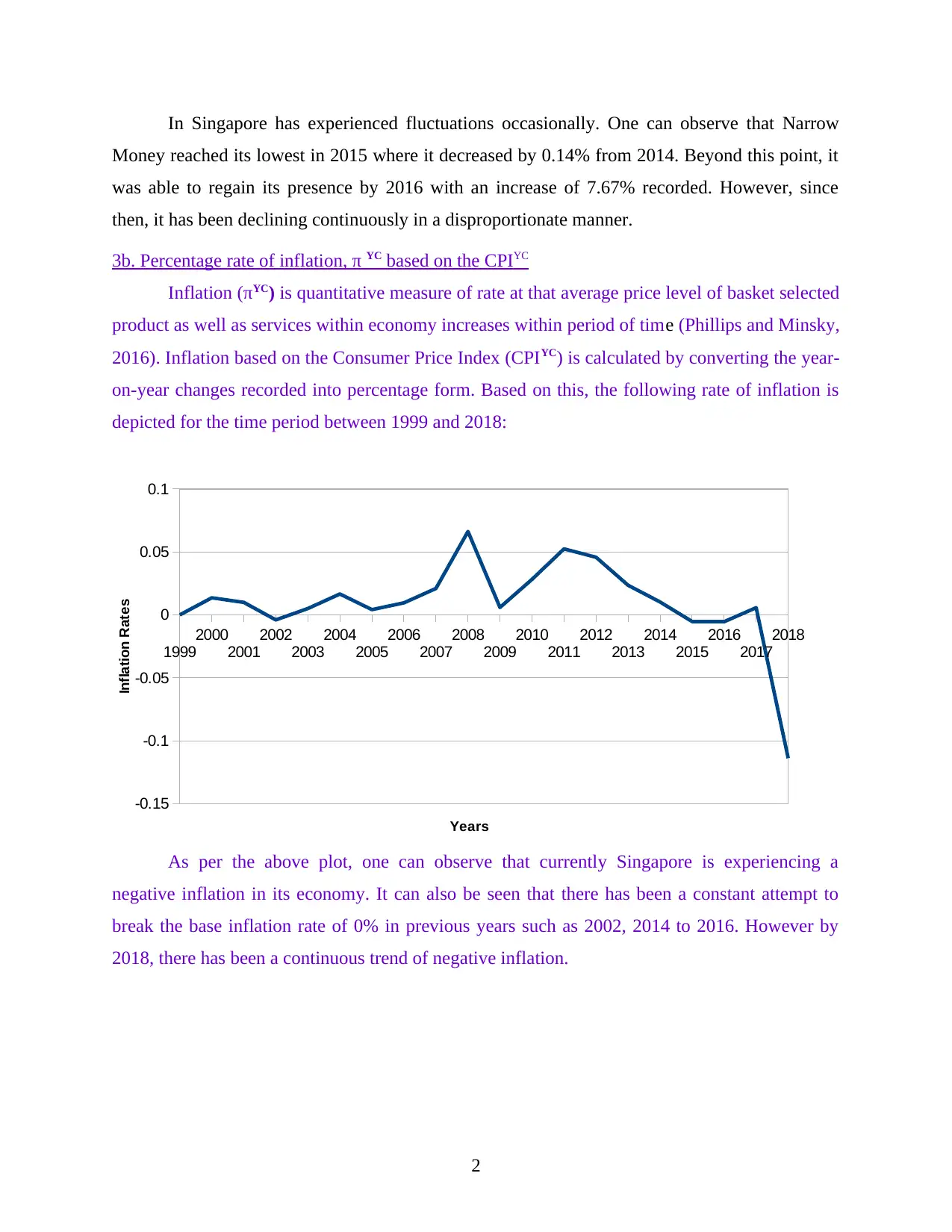
In Singapore has experienced fluctuations occasionally. One can observe that Narrow
Money reached its lowest in 2015 where it decreased by 0.14% from 2014. Beyond this point, it
was able to regain its presence by 2016 with an increase of 7.67% recorded. However, since
then, it has been declining continuously in a disproportionate manner.
3b. Percentage rate of inflation, π YC based on the CPIYC
Inflation (πYC) is quantitative measure of rate at that average price level of basket selected
product as well as services within economy increases within period of time (Phillips and Minsky,
2016). Inflation based on the Consumer Price Index (CPIYC) is calculated by converting the year-
on-year changes recorded into percentage form. Based on this, the following rate of inflation is
depicted for the time period between 1999 and 2018:
1999
2000
2001
2002
2003
2004
2005
2006
2007
2008
2009
2010
2011
2012
2013
2014
2015
2016
2017
2018
-0.15
-0.1
-0.05
0
0.05
0.1
Years
Inflation Rates
As per the above plot, one can observe that currently Singapore is experiencing a
negative inflation in its economy. It can also be seen that there has been a constant attempt to
break the base inflation rate of 0% in previous years such as 2002, 2014 to 2016. However by
2018, there has been a continuous trend of negative inflation.
2
Money reached its lowest in 2015 where it decreased by 0.14% from 2014. Beyond this point, it
was able to regain its presence by 2016 with an increase of 7.67% recorded. However, since
then, it has been declining continuously in a disproportionate manner.
3b. Percentage rate of inflation, π YC based on the CPIYC
Inflation (πYC) is quantitative measure of rate at that average price level of basket selected
product as well as services within economy increases within period of time (Phillips and Minsky,
2016). Inflation based on the Consumer Price Index (CPIYC) is calculated by converting the year-
on-year changes recorded into percentage form. Based on this, the following rate of inflation is
depicted for the time period between 1999 and 2018:
1999
2000
2001
2002
2003
2004
2005
2006
2007
2008
2009
2010
2011
2012
2013
2014
2015
2016
2017
2018
-0.15
-0.1
-0.05
0
0.05
0.1
Years
Inflation Rates
As per the above plot, one can observe that currently Singapore is experiencing a
negative inflation in its economy. It can also be seen that there has been a constant attempt to
break the base inflation rate of 0% in previous years such as 2002, 2014 to 2016. However by
2018, there has been a continuous trend of negative inflation.
2
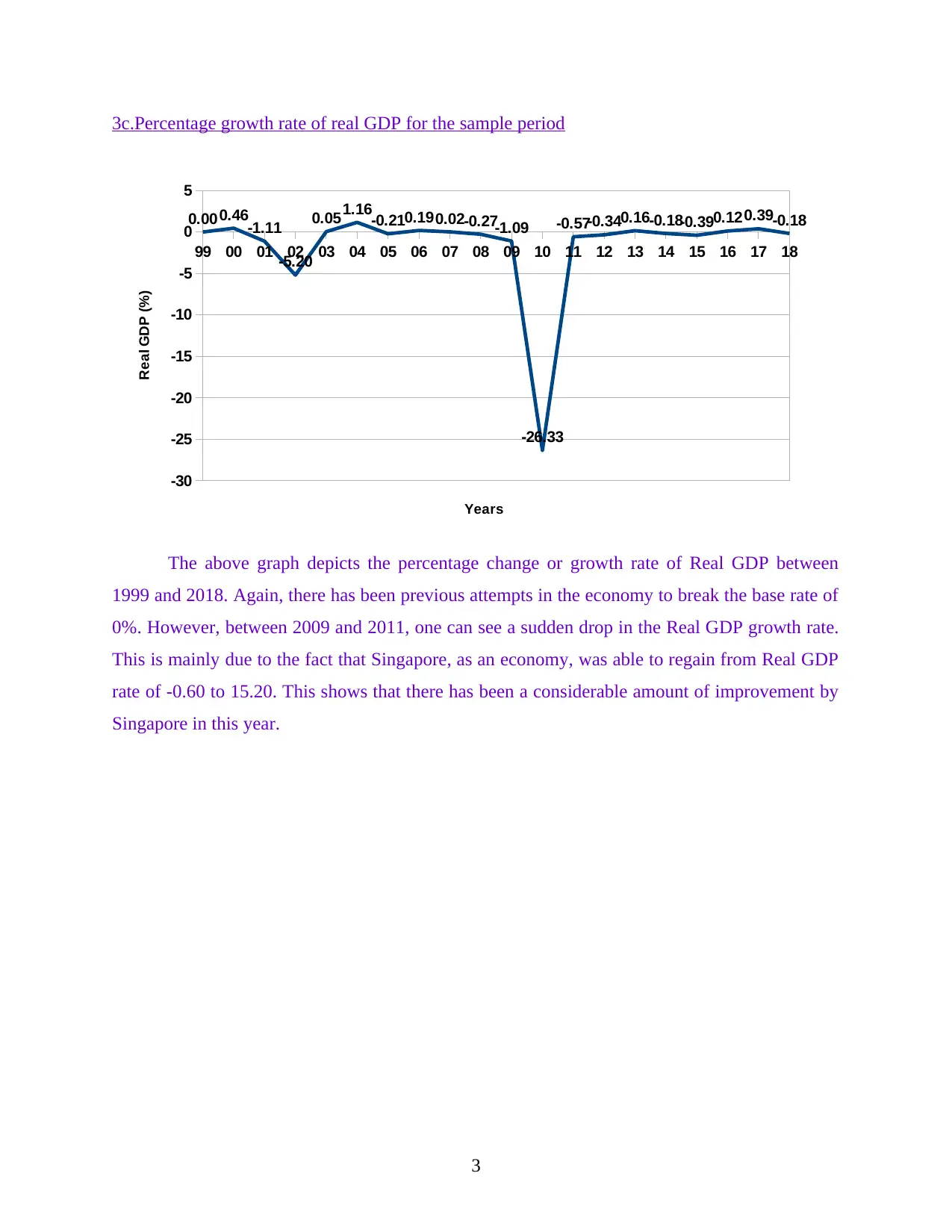
3c.Percentage growth rate of real GDP for the sample period
99 00 01 02 03 04 05 06 07 08 09 10 11 12 13 14 15 16 17 18
-30
-25
-20
-15
-10
-5
0
5
0.000.46-1.11
-5.20
0.051.16-0.210.190.02-0.27-1.09
-26.33
-0.57-0.340.16-0.18-0.390.120.39-0.18
Years
Real GDP (%)
The above graph depicts the percentage change or growth rate of Real GDP between
1999 and 2018. Again, there has been previous attempts in the economy to break the base rate of
0%. However, between 2009 and 2011, one can see a sudden drop in the Real GDP growth rate.
This is mainly due to the fact that Singapore, as an economy, was able to regain from Real GDP
rate of -0.60 to 15.20. This shows that there has been a considerable amount of improvement by
Singapore in this year.
3
99 00 01 02 03 04 05 06 07 08 09 10 11 12 13 14 15 16 17 18
-30
-25
-20
-15
-10
-5
0
5
0.000.46-1.11
-5.20
0.051.16-0.210.190.02-0.27-1.09
-26.33
-0.57-0.340.16-0.18-0.390.120.39-0.18
Years
Real GDP (%)
The above graph depicts the percentage change or growth rate of Real GDP between
1999 and 2018. Again, there has been previous attempts in the economy to break the base rate of
0%. However, between 2009 and 2011, one can see a sudden drop in the Real GDP growth rate.
This is mainly due to the fact that Singapore, as an economy, was able to regain from Real GDP
rate of -0.60 to 15.20. This shows that there has been a considerable amount of improvement by
Singapore in this year.
3
⊘ This is a preview!⊘
Do you want full access?
Subscribe today to unlock all pages.

Trusted by 1+ million students worldwide
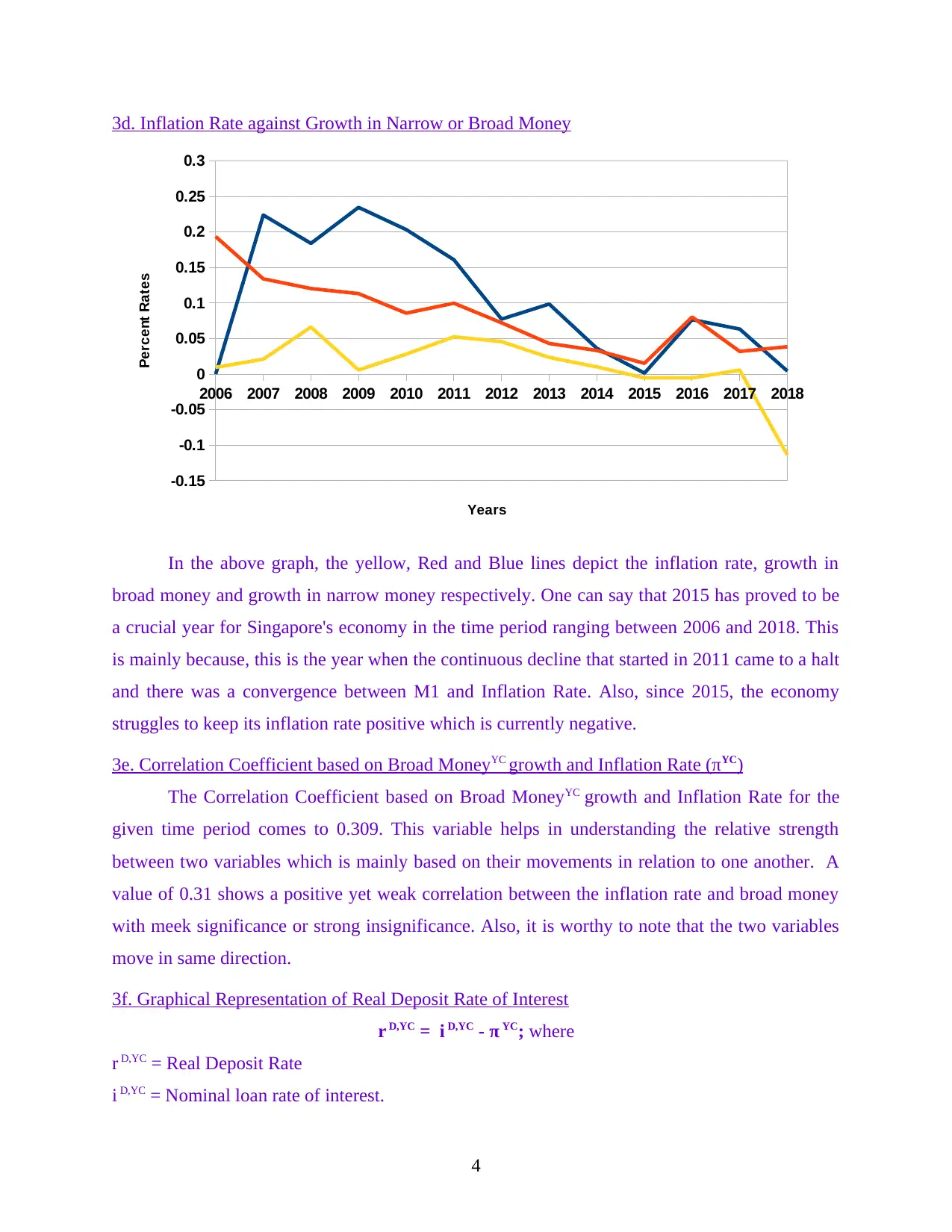
3d. Inflation Rate against Growth in Narrow or Broad Money
2006 2007 2008 2009 2010 2011 2012 2013 2014 2015 2016 2017 2018
-0.15
-0.1
-0.05
0
0.05
0.1
0.15
0.2
0.25
0.3
Years
Percent Rates
In the above graph, the yellow, Red and Blue lines depict the inflation rate, growth in
broad money and growth in narrow money respectively. One can say that 2015 has proved to be
a crucial year for Singapore's economy in the time period ranging between 2006 and 2018. This
is mainly because, this is the year when the continuous decline that started in 2011 came to a halt
and there was a convergence between M1 and Inflation Rate. Also, since 2015, the economy
struggles to keep its inflation rate positive which is currently negative.
3e. Correlation Coefficient based on Broad MoneyYC growth and Inflation Rate (πYC)
The Correlation Coefficient based on Broad MoneyYC growth and Inflation Rate for the
given time period comes to 0.309. This variable helps in understanding the relative strength
between two variables which is mainly based on their movements in relation to one another. A
value of 0.31 shows a positive yet weak correlation between the inflation rate and broad money
with meek significance or strong insignificance. Also, it is worthy to note that the two variables
move in same direction.
3f. Graphical Representation of Real Deposit Rate of Interest
r D,YC = i D,YC - π YC; where
r D,YC = Real Deposit Rate
i D,YC = Nominal loan rate of interest.
4
2006 2007 2008 2009 2010 2011 2012 2013 2014 2015 2016 2017 2018
-0.15
-0.1
-0.05
0
0.05
0.1
0.15
0.2
0.25
0.3
Years
Percent Rates
In the above graph, the yellow, Red and Blue lines depict the inflation rate, growth in
broad money and growth in narrow money respectively. One can say that 2015 has proved to be
a crucial year for Singapore's economy in the time period ranging between 2006 and 2018. This
is mainly because, this is the year when the continuous decline that started in 2011 came to a halt
and there was a convergence between M1 and Inflation Rate. Also, since 2015, the economy
struggles to keep its inflation rate positive which is currently negative.
3e. Correlation Coefficient based on Broad MoneyYC growth and Inflation Rate (πYC)
The Correlation Coefficient based on Broad MoneyYC growth and Inflation Rate for the
given time period comes to 0.309. This variable helps in understanding the relative strength
between two variables which is mainly based on their movements in relation to one another. A
value of 0.31 shows a positive yet weak correlation between the inflation rate and broad money
with meek significance or strong insignificance. Also, it is worthy to note that the two variables
move in same direction.
3f. Graphical Representation of Real Deposit Rate of Interest
r D,YC = i D,YC - π YC; where
r D,YC = Real Deposit Rate
i D,YC = Nominal loan rate of interest.
4
Paraphrase This Document
Need a fresh take? Get an instant paraphrase of this document with our AI Paraphraser
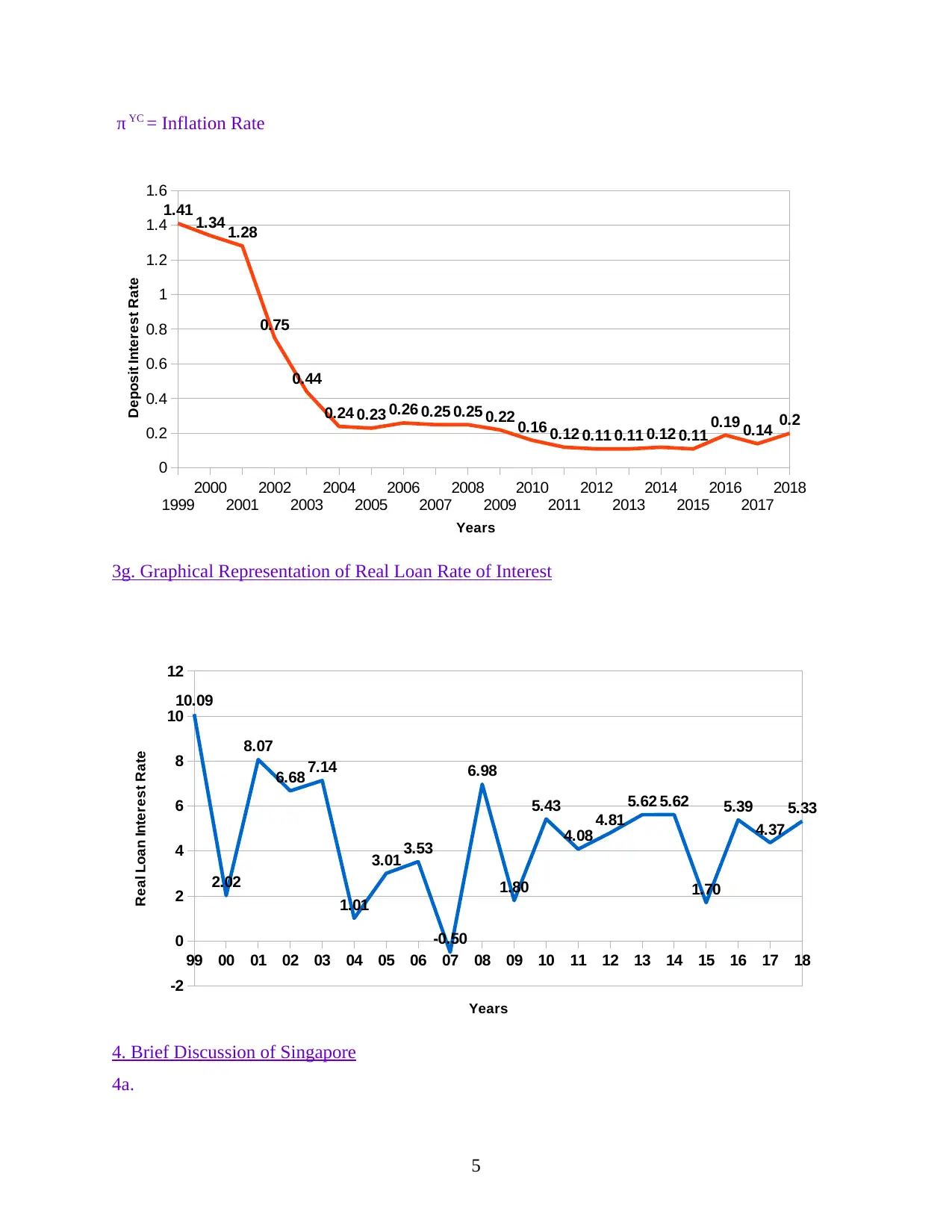
π YC = Inflation Rate
1999
2000
2001
2002
2003
2004
2005
2006
2007
2008
2009
2010
2011
2012
2013
2014
2015
2016
2017
2018
0
0.2
0.4
0.6
0.8
1
1.2
1.4
1.6
1.41 1.34 1.28
0.75
0.44
0.24 0.23 0.26 0.25 0.25 0.22 0.16 0.12 0.11 0.11 0.12 0.11 0.19 0.14 0.2
Years
Deposit Interest Rate
3g. Graphical Representation of Real Loan Rate of Interest
99 00 01 02 03 04 05 06 07 08 09 10 11 12 13 14 15 16 17 18
-2
0
2
4
6
8
10
12
10.09
2.02
8.07
6.68 7.14
1.01
3.01 3.53
-0.50
6.98
1.80
5.43
4.08
4.81
5.62 5.62
1.70
5.39
4.37
5.33
Years
Real Loan Interest Rate
4. Brief Discussion of Singapore
4a.
5
1999
2000
2001
2002
2003
2004
2005
2006
2007
2008
2009
2010
2011
2012
2013
2014
2015
2016
2017
2018
0
0.2
0.4
0.6
0.8
1
1.2
1.4
1.6
1.41 1.34 1.28
0.75
0.44
0.24 0.23 0.26 0.25 0.25 0.22 0.16 0.12 0.11 0.11 0.12 0.11 0.19 0.14 0.2
Years
Deposit Interest Rate
3g. Graphical Representation of Real Loan Rate of Interest
99 00 01 02 03 04 05 06 07 08 09 10 11 12 13 14 15 16 17 18
-2
0
2
4
6
8
10
12
10.09
2.02
8.07
6.68 7.14
1.01
3.01 3.53
-0.50
6.98
1.80
5.43
4.08
4.81
5.62 5.62
1.70
5.39
4.37
5.33
Years
Real Loan Interest Rate
4. Brief Discussion of Singapore
4a.
5
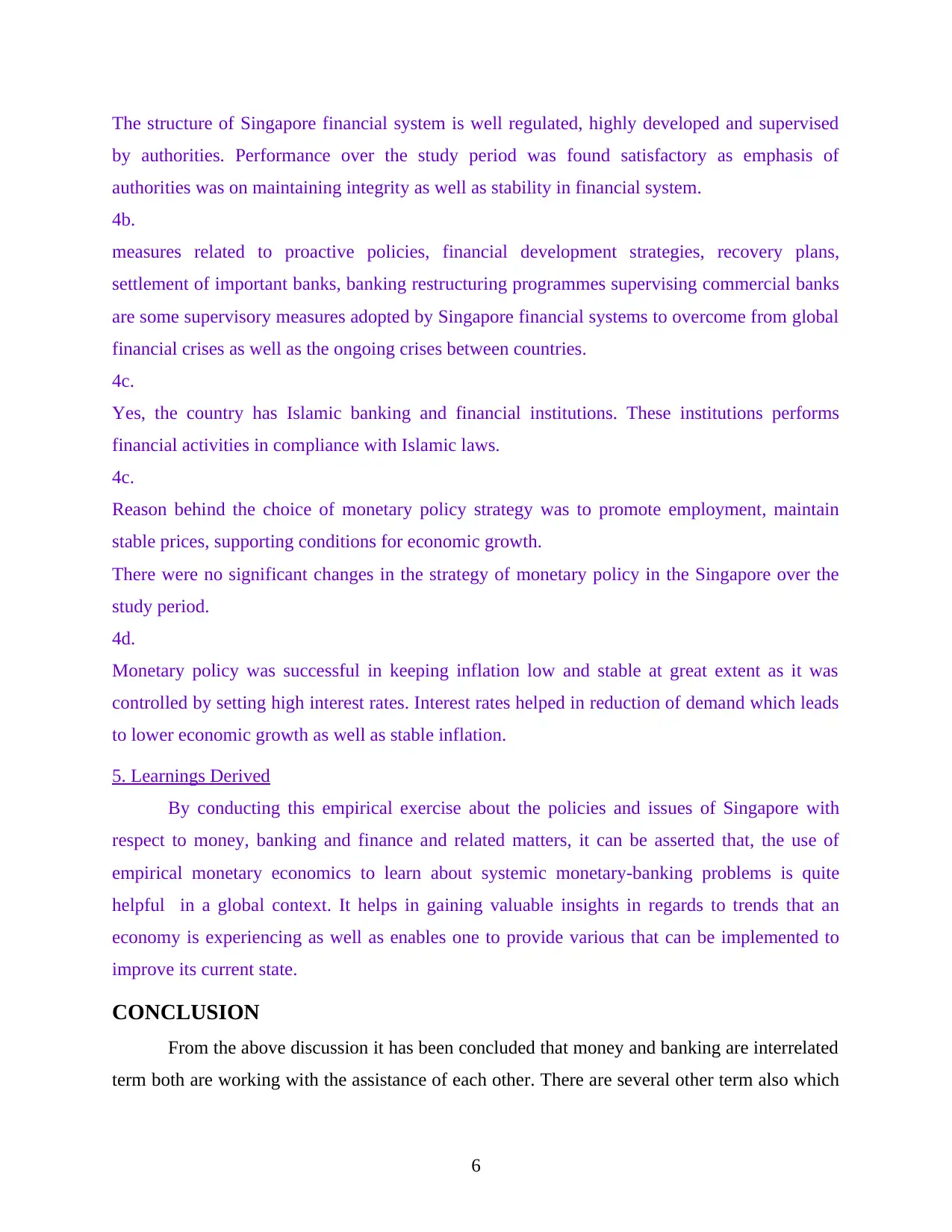
The structure of Singapore financial system is well regulated, highly developed and supervised
by authorities. Performance over the study period was found satisfactory as emphasis of
authorities was on maintaining integrity as well as stability in financial system.
4b.
measures related to proactive policies, financial development strategies, recovery plans,
settlement of important banks, banking restructuring programmes supervising commercial banks
are some supervisory measures adopted by Singapore financial systems to overcome from global
financial crises as well as the ongoing crises between countries.
4c.
Yes, the country has Islamic banking and financial institutions. These institutions performs
financial activities in compliance with Islamic laws.
4c.
Reason behind the choice of monetary policy strategy was to promote employment, maintain
stable prices, supporting conditions for economic growth.
There were no significant changes in the strategy of monetary policy in the Singapore over the
study period.
4d.
Monetary policy was successful in keeping inflation low and stable at great extent as it was
controlled by setting high interest rates. Interest rates helped in reduction of demand which leads
to lower economic growth as well as stable inflation.
5. Learnings Derived
By conducting this empirical exercise about the policies and issues of Singapore with
respect to money, banking and finance and related matters, it can be asserted that, the use of
empirical monetary economics to learn about systemic monetary-banking problems is quite
helpful in a global context. It helps in gaining valuable insights in regards to trends that an
economy is experiencing as well as enables one to provide various that can be implemented to
improve its current state.
CONCLUSION
From the above discussion it has been concluded that money and banking are interrelated
term both are working with the assistance of each other. There are several other term also which
6
by authorities. Performance over the study period was found satisfactory as emphasis of
authorities was on maintaining integrity as well as stability in financial system.
4b.
measures related to proactive policies, financial development strategies, recovery plans,
settlement of important banks, banking restructuring programmes supervising commercial banks
are some supervisory measures adopted by Singapore financial systems to overcome from global
financial crises as well as the ongoing crises between countries.
4c.
Yes, the country has Islamic banking and financial institutions. These institutions performs
financial activities in compliance with Islamic laws.
4c.
Reason behind the choice of monetary policy strategy was to promote employment, maintain
stable prices, supporting conditions for economic growth.
There were no significant changes in the strategy of monetary policy in the Singapore over the
study period.
4d.
Monetary policy was successful in keeping inflation low and stable at great extent as it was
controlled by setting high interest rates. Interest rates helped in reduction of demand which leads
to lower economic growth as well as stable inflation.
5. Learnings Derived
By conducting this empirical exercise about the policies and issues of Singapore with
respect to money, banking and finance and related matters, it can be asserted that, the use of
empirical monetary economics to learn about systemic monetary-banking problems is quite
helpful in a global context. It helps in gaining valuable insights in regards to trends that an
economy is experiencing as well as enables one to provide various that can be implemented to
improve its current state.
CONCLUSION
From the above discussion it has been concluded that money and banking are interrelated
term both are working with the assistance of each other. There are several other term also which
6
⊘ This is a preview!⊘
Do you want full access?
Subscribe today to unlock all pages.

Trusted by 1+ million students worldwide
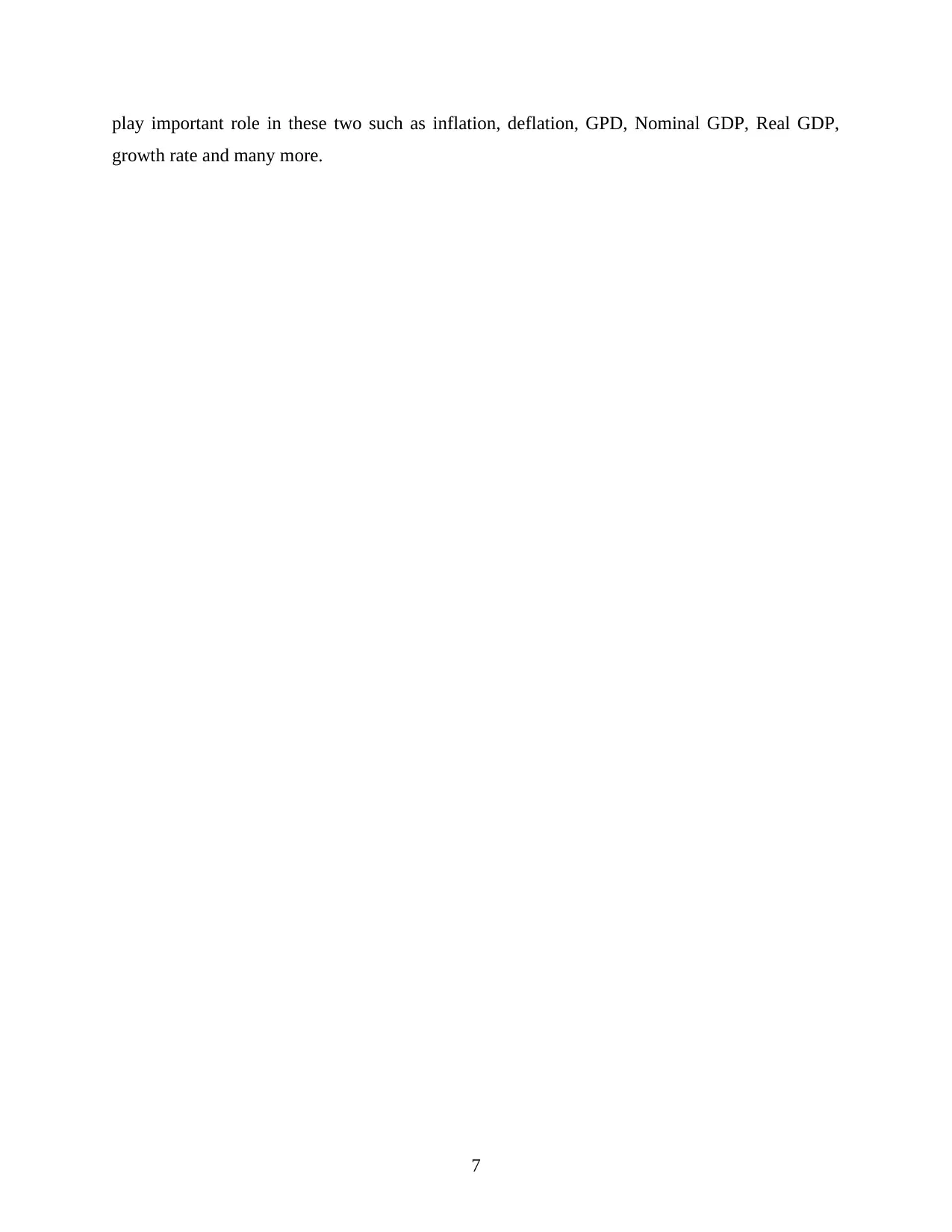
play important role in these two such as inflation, deflation, GPD, Nominal GDP, Real GDP,
growth rate and many more.
7
growth rate and many more.
7
Paraphrase This Document
Need a fresh take? Get an instant paraphrase of this document with our AI Paraphraser
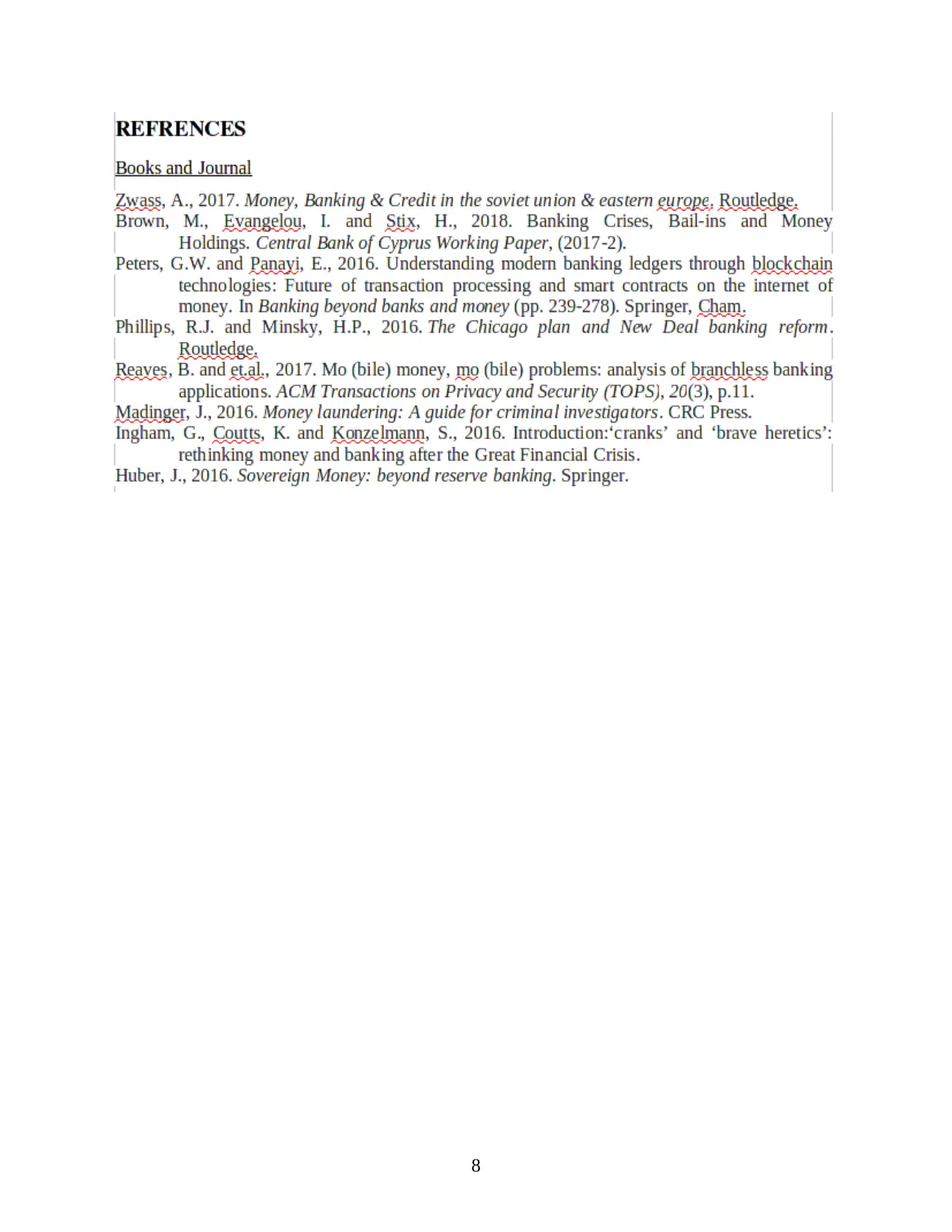
8
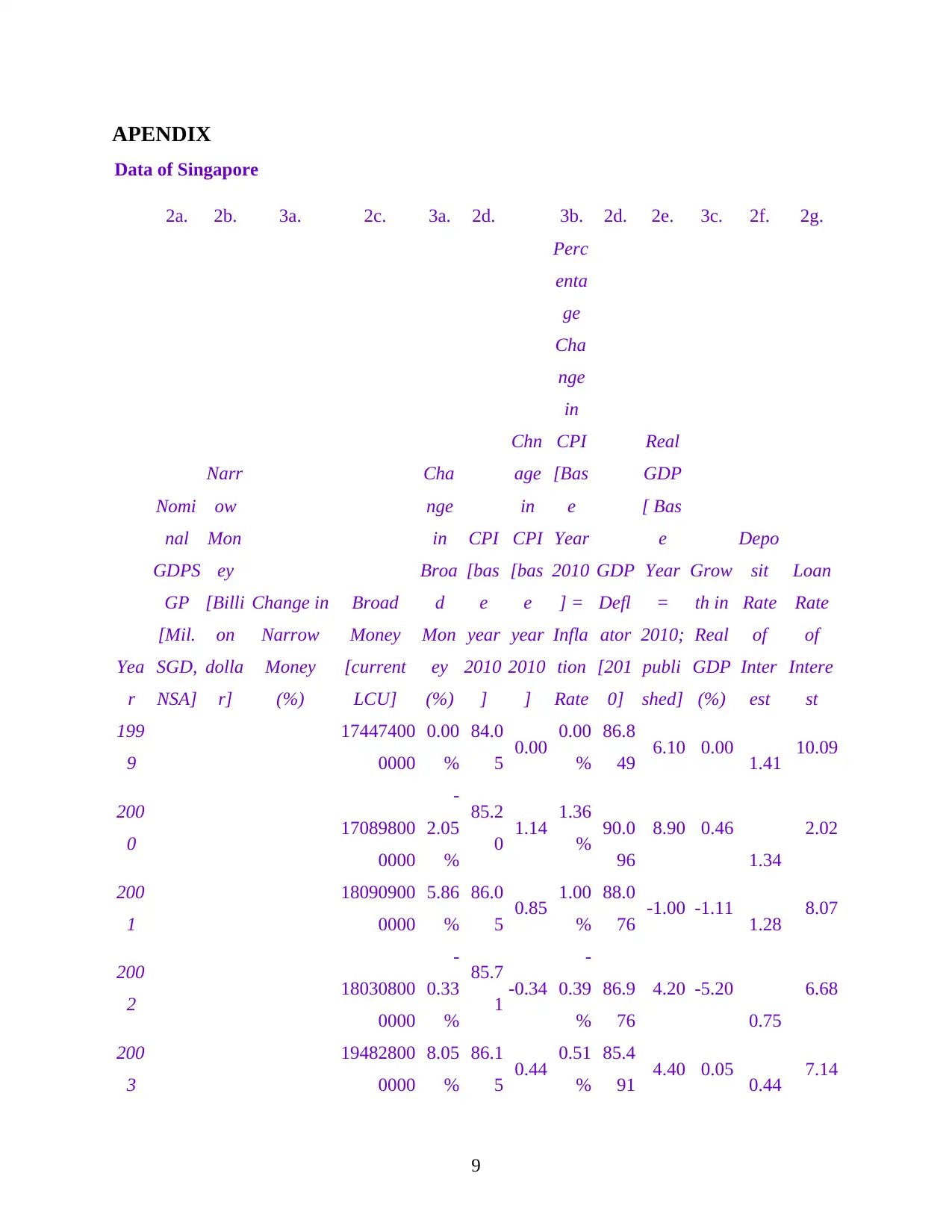
APENDIX
Data of Singapore
2a. 2b. 3a. 2c. 3a. 2d. 3b. 2d. 2e. 3c. 2f. 2g.
Yea
r
Nomi
nal
GDPS
GP
[Mil.
SGD,
NSA]
Narr
ow
Mon
ey
[Billi
on
dolla
r]
Change in
Narrow
Money
(%)
Broad
Money
[current
LCU]
Cha
nge
in
Broa
d
Mon
ey
(%)
CPI
[bas
e
year
2010
]
Chn
age
in
CPI
[bas
e
year
2010
]
Perc
enta
ge
Cha
nge
in
CPI
[Bas
e
Year
2010
] =
Infla
tion
Rate
GDP
Defl
ator
[201
0]
Real
GDP
[ Bas
e
Year
=
2010;
publi
shed]
Grow
th in
Real
GDP
(%)
Depo
sit
Rate
of
Inter
est
Loan
Rate
of
Intere
st
199
9
17447400
0000
0.00
%
84.0
5 0.00 0.00
%
86.8
49 6.10 0.00 1.41 10.09
200
0 17089800
0000
-
2.05
%
85.2
0 1.14 1.36
% 90.0
96
8.90 0.46
1.34
2.02
200
1
18090900
0000
5.86
%
86.0
5 0.85 1.00
%
88.0
76 -1.00 -1.11 1.28 8.07
200
2 18030800
0000
-
0.33
%
85.7
1 -0.34
-
0.39
%
86.9
76
4.20 -5.20
0.75
6.68
200
3
19482800
0000
8.05
%
86.1
5 0.44 0.51
%
85.4
91 4.40 0.05 0.44 7.14
9
Data of Singapore
2a. 2b. 3a. 2c. 3a. 2d. 3b. 2d. 2e. 3c. 2f. 2g.
Yea
r
Nomi
nal
GDPS
GP
[Mil.
SGD,
NSA]
Narr
ow
Mon
ey
[Billi
on
dolla
r]
Change in
Narrow
Money
(%)
Broad
Money
[current
LCU]
Cha
nge
in
Broa
d
Mon
ey
(%)
CPI
[bas
e
year
2010
]
Chn
age
in
CPI
[bas
e
year
2010
]
Perc
enta
ge
Cha
nge
in
CPI
[Bas
e
Year
2010
] =
Infla
tion
Rate
GDP
Defl
ator
[201
0]
Real
GDP
[ Bas
e
Year
=
2010;
publi
shed]
Grow
th in
Real
GDP
(%)
Depo
sit
Rate
of
Inter
est
Loan
Rate
of
Intere
st
199
9
17447400
0000
0.00
%
84.0
5 0.00 0.00
%
86.8
49 6.10 0.00 1.41 10.09
200
0 17089800
0000
-
2.05
%
85.2
0 1.14 1.36
% 90.0
96
8.90 0.46
1.34
2.02
200
1
18090900
0000
5.86
%
86.0
5 0.85 1.00
%
88.0
76 -1.00 -1.11 1.28 8.07
200
2 18030800
0000
-
0.33
%
85.7
1 -0.34
-
0.39
%
86.9
76
4.20 -5.20
0.75
6.68
200
3
19482800
0000
8.05
%
86.1
5 0.44 0.51
%
85.4
91 4.40 0.05 0.44 7.14
9
⊘ This is a preview!⊘
Do you want full access?
Subscribe today to unlock all pages.

Trusted by 1+ million students worldwide

200
4
20697800
0000
6.24
%
87.5
8 1.43 1.66
%
89.1
24 9.50 1.16 0.24 1.01
200
5
21979800
0000
6.19
%
87.9
5 0.37 0.43
%
91.1
08 7.50 -0.21 0.23 3.01
200
6
2,34,8
35.0 52.2 0.00% 26237000
0000
19.3
7%
88.8
0 0.85 0.96
%
92.6
75 8.90 0.19 0.26 3.53
200
7
2,71,2
49.0 63.9 22.39% 29755900
0000
13.4
1%
90.6
7 1.87 2.10
%
98.1
07 9.10 0.02 0.25 -0.50
200
8
2,71,9
80.0 75.7 18.40% 33341000
0000
12.0
5%
96.6
8 6.01 6.63
%
96.6
43 6.60 -0.27 0.25 6.98
200
9
2,79,8
58.0 93.5 23.47% 37120900
0000
11.3
4%
97.2
5 0.58 0.60
%
100.
046 -0.60 -1.09 0.22 1.80
201
0
3,22,3
61.0
112.
5 20.34% 40309700
0000
8.59
%
100.
00 2.75 2.82
% 100 15.20 -
26.33 0.16 5.43
201
1
3,47,9
28.0
130.
6 16.10% 44335800
0000
9.99
%
105.
25 5.25 5.25
%
101.
163 6.50 -0.57 0.12 4.08
201
2
3,64,4
17.0
140.
7 7.75% 47539200
0000
7.23
%
110.
06 4.82 4.58
%
102.
084 4.30 -0.34 0.11 4.81
201
3
3,81,8
43.0
154.
6 9.87% 49590900
0000
4.32
%
112.
66 2.60 2.36
%
101.
795 5.00 0.16 0.11 5.62
201
4
3,96,9
16.0
160.
2 3.64% 51243100
0000
3.33
%
113.
81 1.15 1.02
%
101.
18 4.10 -0.18 0.12 5.62
201
5
4,21,0
46.0
160.
4 0.14% 52024000
0000
1.52
%
113.
22 -0.59
-
0.52
%
102.
839
2.50 -0.39
0.11
1.70
201
6
4,37,3
39.0
172.
8 7.67% 56208800
0000
8.04
%
112.
62 -0.60
-
0.53
%
103.
924
2.80 0.12 0.19 5.39
201
7
4,64,9
28.0
183.
7 6.34% 58006670
0000
3.20
%
113.
27 0.65 0.58
%
104.
515 3.90 0.39 0.14 4.37
201 4,87,0 184. 0.43% 60243300 3.86 100. - - 105. 3.20 -0.18 0.20 5.33
10
4
20697800
0000
6.24
%
87.5
8 1.43 1.66
%
89.1
24 9.50 1.16 0.24 1.01
200
5
21979800
0000
6.19
%
87.9
5 0.37 0.43
%
91.1
08 7.50 -0.21 0.23 3.01
200
6
2,34,8
35.0 52.2 0.00% 26237000
0000
19.3
7%
88.8
0 0.85 0.96
%
92.6
75 8.90 0.19 0.26 3.53
200
7
2,71,2
49.0 63.9 22.39% 29755900
0000
13.4
1%
90.6
7 1.87 2.10
%
98.1
07 9.10 0.02 0.25 -0.50
200
8
2,71,9
80.0 75.7 18.40% 33341000
0000
12.0
5%
96.6
8 6.01 6.63
%
96.6
43 6.60 -0.27 0.25 6.98
200
9
2,79,8
58.0 93.5 23.47% 37120900
0000
11.3
4%
97.2
5 0.58 0.60
%
100.
046 -0.60 -1.09 0.22 1.80
201
0
3,22,3
61.0
112.
5 20.34% 40309700
0000
8.59
%
100.
00 2.75 2.82
% 100 15.20 -
26.33 0.16 5.43
201
1
3,47,9
28.0
130.
6 16.10% 44335800
0000
9.99
%
105.
25 5.25 5.25
%
101.
163 6.50 -0.57 0.12 4.08
201
2
3,64,4
17.0
140.
7 7.75% 47539200
0000
7.23
%
110.
06 4.82 4.58
%
102.
084 4.30 -0.34 0.11 4.81
201
3
3,81,8
43.0
154.
6 9.87% 49590900
0000
4.32
%
112.
66 2.60 2.36
%
101.
795 5.00 0.16 0.11 5.62
201
4
3,96,9
16.0
160.
2 3.64% 51243100
0000
3.33
%
113.
81 1.15 1.02
%
101.
18 4.10 -0.18 0.12 5.62
201
5
4,21,0
46.0
160.
4 0.14% 52024000
0000
1.52
%
113.
22 -0.59
-
0.52
%
102.
839
2.50 -0.39
0.11
1.70
201
6
4,37,3
39.0
172.
8 7.67% 56208800
0000
8.04
%
112.
62 -0.60
-
0.53
%
103.
924
2.80 0.12 0.19 5.39
201
7
4,64,9
28.0
183.
7 6.34% 58006670
0000
3.20
%
113.
27 0.65 0.58
%
104.
515 3.90 0.39 0.14 4.37
201 4,87,0 184. 0.43% 60243300 3.86 100. - - 105. 3.20 -0.18 0.20 5.33
10
1 out of 13
Related Documents
Your All-in-One AI-Powered Toolkit for Academic Success.
+13062052269
info@desklib.com
Available 24*7 on WhatsApp / Email
![[object Object]](/_next/static/media/star-bottom.7253800d.svg)
Unlock your academic potential
© 2024 | Zucol Services PVT LTD | All rights reserved.





